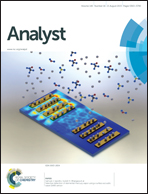Formation of copper nanoparticles on poly(thymine) through surface-initiated enzymatic polymerization and its application for DNA detection
Abstract
Poly(thymine) (polyT) and double-stranded DNA (dsDNA) can act as efficient templates for the formation of copper nanoparticles (CuNPs) at a low concentration of CuSO4, and the formed CuNPs emit excellent fluorescence. In this work, we demonstrated a new and facile strategy for the highly sensitive and selective detection of DNA on streptavidin-functionalized magnetic beads (SA-MB) using DNA-templated CuNPs as the fluorescent probe. Target DNA (tDNA) was hybridized with the capture DNA that was immobilized on the surface of SA-MB. Surface initiated enzymatic polymerization (SIEP) was employed as the signal amplification method to generate the polyT at the 3′ end of tDNA for the formation of CuNPs. The incorporation of polyT by SIEP resulted in ∼35.7 fold signal amplification compared to the dsDNA after hybridization without SIEP. A dose–response curve for detection of DNA was obtained, with a linear dynamic range of 0.1 nM to 10 nM. We showed that this method has a low pM limit of detection (LOD 98.2 pM) and it is also very sensitive to the mismatch type in a specific DNA sequence. In addition, it avoids rigorously controlled temperature, complex synthesis of the fluorescent probe and prelabeling of DNA strands and eliminates the use of sophisticated experimental techniques and equipment. Armed with these intriguing properties, the proposed system could provide an efficient tool for early diagnosis and risk assessment of malignancy.


 Please wait while we load your content...
Please wait while we load your content...